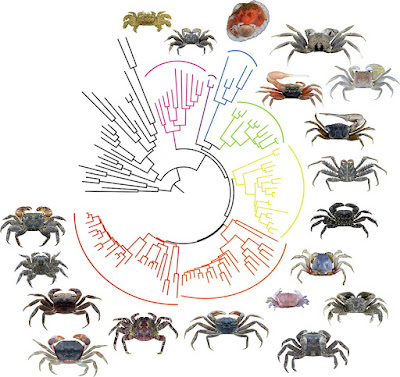 |
| Molecular Phylogeny of Thoracotremata Crabs (Decapoda, Brachyura) in Tsang, Schubart, Chu, et al., 2022. |
Highlights:
• Thoracotreme crabs invaded terrestrial habitat through direct invasion route during Late Cretaceous.
• Secondary invasions into subtidal regions and colonization of freshwater habitats occurred in multiple lineages.
• Symbiosis evolved at least two times in Thoracotremata.
• Most thoracotreme superfamilies are polyphyletic and a new seven superfamilies classification scheme is proposed.
Abstract
The Thoracotremata is a large and successful group of “true” crabs (Decapoda, Brachyura, Eubrachyura) with a great diversity of lifestyles and well-known intertidal representatives. The group represents the largest brachyuran radiation into terrestrial and semi-terrestrial environments and comprises multiple lineages of obligate symbiotic species. In consequence, they exhibit very diverse physiological and morphological adaptations. Our understanding of their evolution is, however, largely obscured by their confused classification. Here, we resolve interfamilial relationships of Thoracotremata, using 10 molecular markers and exemplars from all nominal families in order to reconstruct the pathways of lifestyle transition and to propose a new taxonomy corresponding to phylogenetic relationships. The results confirm the polyphyly of three superfamilies as currently defined (Grapsoidea, Ocypodoidea and Pinnotheroidea). At the family level, Dotillidae, Macrophthalmidae, and Varunidae are not monophyletic. Ancestral state reconstruction analyses and divergent time estimations indicate that the common ancestor of thoracotremes already thrived in intertidal environments in the Late Cretaceous and terrestrialization became a major driver of thoracotreme diversification. Multiple semi-terrestrial and terrestrial lineages originated and radiated in the Early Eocene, coinciding with the global warming event at the Paleocene-Eocene Thermal Maximum (PETM). Secondary invasions into subtidal regions and colonizations of freshwater habitats occurred independently through multiple semi-terrestrial and terrestrial lineages. Obligate symbiosis between thoracotremes and other marine macro-invertebrates evolved at least twice. On the basis of the current molecular phylogenetic hypothesis, it will be necessary in the future to revise and recognize seven monophyletic superfamilies and revisit the morphological character states which define them.
Chandler T. T. Tsang, Christoph D. Schubart, Ka Hou Chu, Peter K. L. Ng and Ling Ming Tsang. 2022. Molecular Phylogeny of Thoracotremata Crabs (Decapoda, Brachyura): Toward Adopting Monophyletic Superfamilies, Invasion History into Terrestrial Habitats and Multiple Origins of Symbiosis. Molecular Phylogenetics and Evolution. In Press, 107596. DOI: 10.1016/j.ympev.2022.107596

